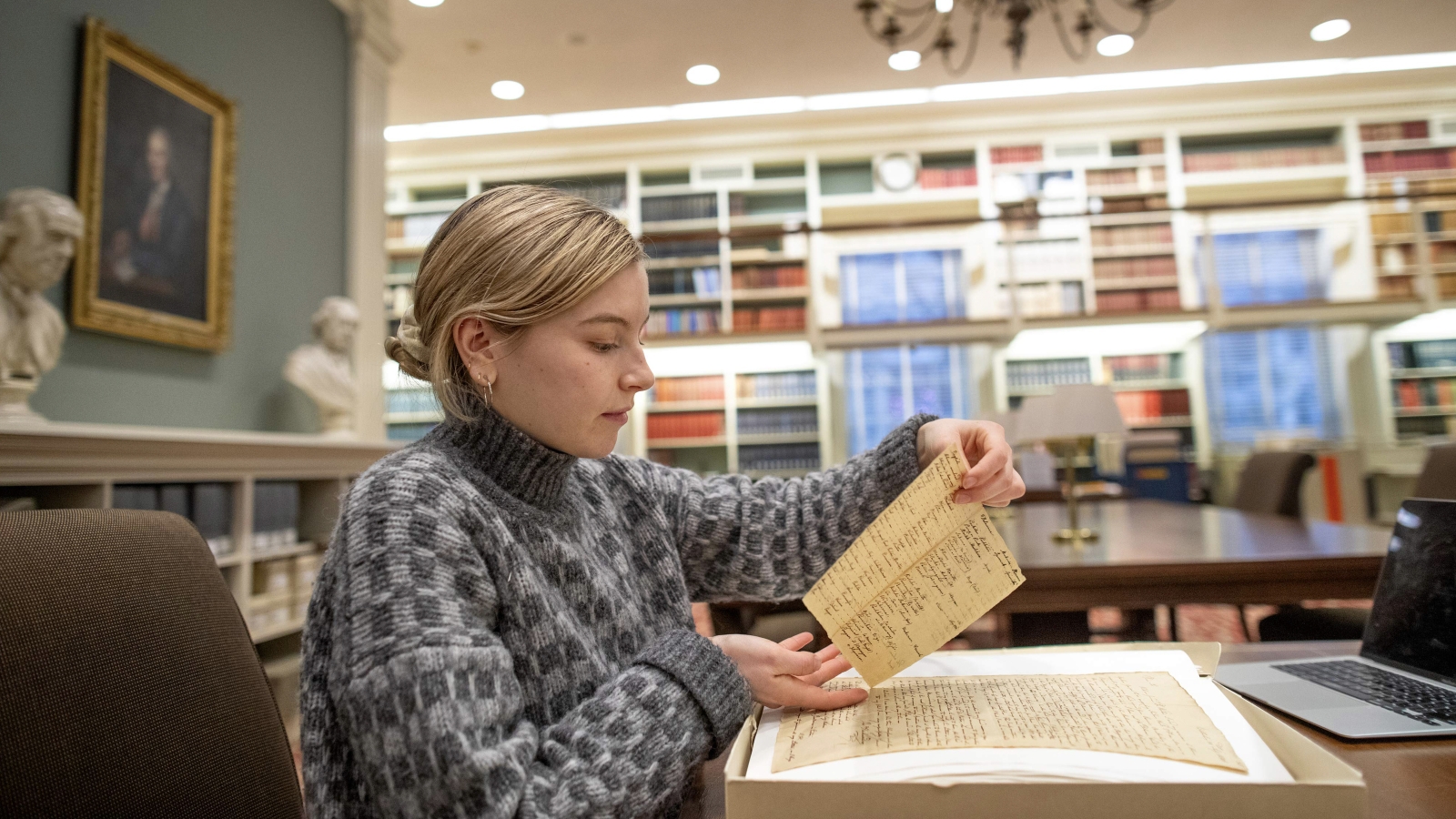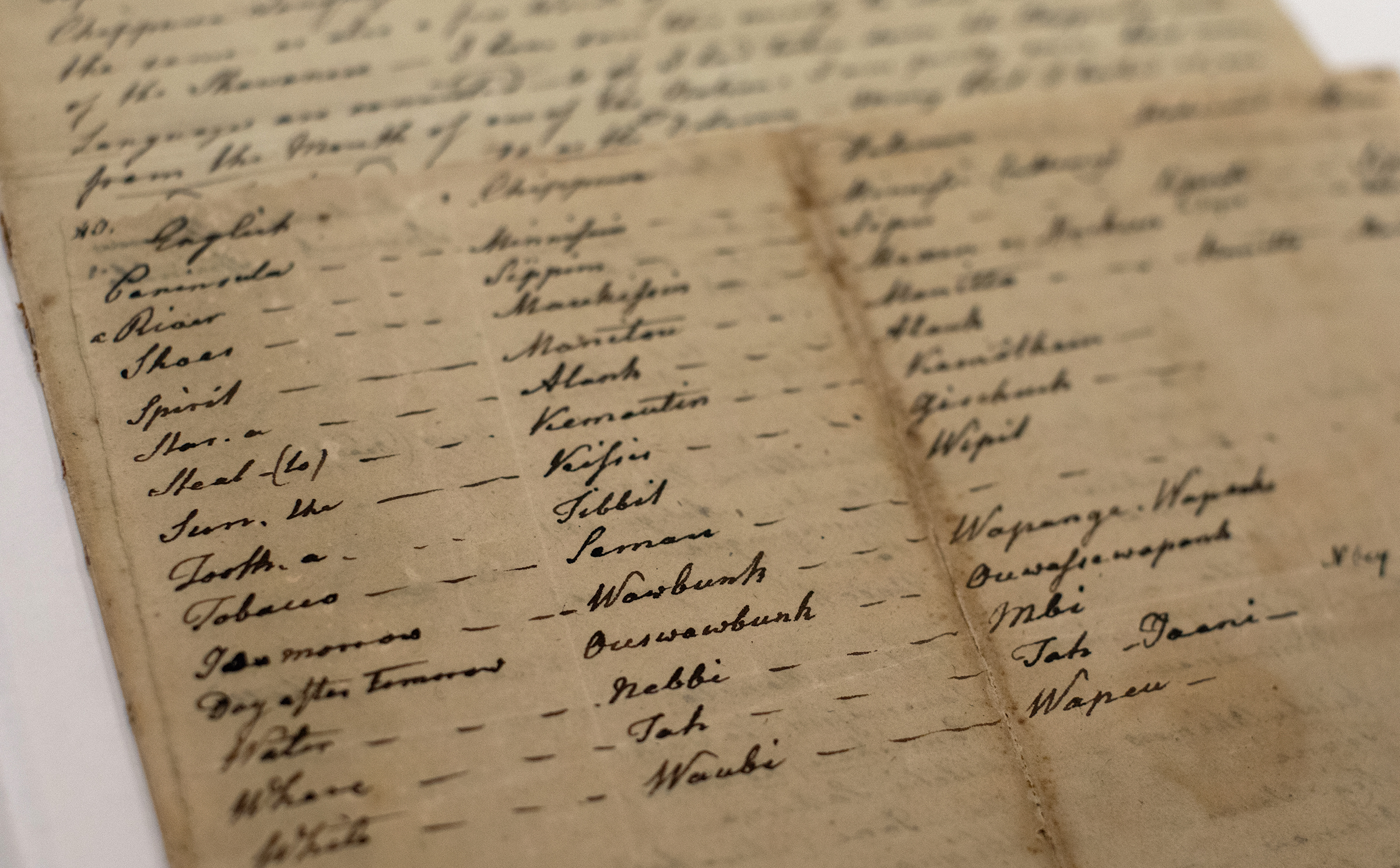Lessons From 17th Century “New Netherland”
Through study of the fur and wampum trade between the Lenape and Dutch in the 1600s, fourth-year history Ph.D. candidate Molly Leech is aiming to recenter Indigenous contributions to global trade.

The reading room at the American Philosophical Society in Philadelphia is nearly silent but for Marian “Molly” Leech’s slow and deliberate page-turning, the fragile sheets she’s inspecting yellowed by the passage of time. Outside, rain is pounding. In the carpeted room, book-lined walls and large white busts flank several long wooden tables.
Leech, a fourth-year Ph.D. candidate in the Department of History, is there studying the personal correspondence of John Heckewelder, a missionary and linguist who, in the 1800s, lived in Gnadenhutten, Ohio, among a Lenape community that had converted to Christianity. “He was really interested in the Lenape language,” Leech says. “Of course, every colonial source is problematic, but he provides insights that Dutch colonists didn’t have in the earlier time period or weren’t interested in recording.”
The collection’s 113 private letters and other papers offer a glimpse into life several hundred years ago in what is today New Jersey, southern New York, and Pennsylvania. Heckewelder, who recorded and translated many of the area’s Lenape place names, also wrote about the Lenape’s relations with neighboring groups, as well as their views on animals.
In Leech’s research—in the reading room that day, during an ongoing fellowship at the Rijksmuseum in Amsterdam, at archives in New York and New Jersey—she has been flagging any such references to the non-human world or the fur trade, specifically those that relate to the Dutch colony of New Netherland and beaver pelts. In particular, she’s curious about the exchange of goods that took place there in the 1600s and how differently the groups doing the swapping related to the non-human world.
“Colonists didn’t just arrive and trade but claimed Native homelands as their possession,” she explains. “I’m interested in how this distorted many settlers’ views of the landscape, how it obfuscates the region’s deep Indigenous histories—histories that are often not fully discussed in colonial sources or are purposefully downplayed.”

Molly Leech is a fourth-year doctoral candidate in the Department of History.
Hometown History
For the better part of the past decade, Leech has made a habit of learning about the history of people and places. As an undergraduate at Lafayette College, she studied anthropology, then earned a master’s degree in archaeology from Leiden University in the Netherlands. When she began her Ph.D. at Penn, Leech planned to study early colonial northeastern American history, but within that, needed an area of specialization.
She’d always been curious about her hometown in Monmouth County, New Jersey, a place that was also the ancestral home of a group of Lenape called the Navesink. “References to this community are few and far between, which could be because they were intent on keeping colonists out of their communities,” says Daniel K. Richter, Roy F. and Jeannette P. Nichols Professor of American History Emeritus and one of Leech’s advisors.
One way they did interact with the settlers, however, was trading fur and wampum—beads made from whelk and quahog shells—a tradition that far predated the arrival of the Dutch in 1609. “To make a very long story short, because we’re literally talking about thousands of years, there were these massive trade networks that centered on the exchange of rare and presumably powerful goods like shell beads,” Richter explains. “They had deep significance to Native peoples that settlers don’t understand very well.”
In New Netherland, trading between the Dutch West India Company and Lenape took place throughout most of the 1600s. “Furs and wampum were the two materials in New Netherland tasked with reinforcing diplomatic views and understanding,” Leech says. “It was more complex than just an economic exchange.” Part of that had to do with Indigenous patterns of diplomacy and the animal whose fur was being traded, according to Leech’s research so far, as well as consultation with Margaret Bruchac, Professor Emerita in the Department of Anthropology, and close collaborators among the Lenape.
The Role of the Beaver
When Leech references beaver, she’s talking about two species, the Eurasian beaver, Castor fiber, found on the European continent, and the North American beaver, Castor canadensis. Leech says that within this context, there are many animal histories that could be told; she’s intrigued by this particular one for many reasons, like the profound effect beavers have on the environment, the fact that they were hunted nearly to extinction in western Europe, and their designation as “other-than-human kin” by the Lenape and other Indigenous groups.
“Mapping Lenapehoking”
In addition to the dissertation work Molly Leech is conducting, she is serving as research assistant to another project: a graphic novel and website called “Mapping Lenapehoking,” directed by Margaret Bruchac, Professor Emerita in the Department of Anthropology. This project, in collaboration with Curtis Zunigha (Delaware Tribe), Lenape historian, and Lee Francis (Laguna Pueblo), founder of Native Realities Press, focuses on “reclaiming and re-inscribing Indigenous histories of place, while interrogating the distorting effects of settler colonial history.”
The primary goal, states Bruchac, is to make Indigenous Lenape histories in today’s eastern Pennsylvania, New Jersey, and southern New York more visible by “critically re-evaluating colonial maps and narratives, while emphasizing enduring connections between Lenape peoples and the Lenapehoking homeland.” It will also look forward, re-visioning Indigenous futures by emphasizing enduring connections between Indigenous peoples and their homelands. The initiative is one of several supported by the Mellon Foundation “Dispossessions in the Americas” grant.
“Many Indigenous communities across today’s northeastern America have oral traditions about the giant beaver as an ‘earth-shaper,’” she says, citing work previously conducted by Bruchac.
“These traditions, which recount constantly negotiated reciprocal relationships among human and other-than-human beings,” Bruchac adds, “also record ancient geological events that re-shaped the land itself.”
To learn more about the plight of beaver in western Europe, Leech has been focusing on Medieval bestiaries—detailed texts about animals, both real and imaginary, which she says tend to represent the beaver inaccurately and almost always being hunted—and the writings of 17th-century natural historians. During the first half of her yearlong Dr. Anton C.R. Dreesmann Fellowship at the Rijksmuseum, for instance, she found papers from a mayor, collector, and naturalist in the Dutch Republic who had never traveled to North America yet referred to the North American fur trade and Native customs and beliefs about the beaver. “Often these writers will refer to other scientists who they’ve received information from or other collections they’ve heard about,” she says.
Letters lead to maps and deeds. References to beaver and the fur trade and wampum beget those about diplomatic views and economic exchange.
Leech has two advantages in parsing these details: She’s fluent in Dutch and for years, she has studied paleography, the practice of learning how to decipher older handwriting. “She’s really able to dig into archival sources in the Netherlands and in the U.S. in ways that few other historians have been able to,” Richter says.
Though she’s only about halfway finished with the work, Leech has begun to see patterns emerge. For instance, she’s noticed that the deep history of the beaver in a European context is tied to histories of deforestation and overhunting. Beyond that, “the Dutch are not just arriving and trading and bringing the pelts back to Europe. They’re part of a colonial project that radically transforms the regional ecology and is invested in trying to attract more settlers to Indigenous land,” she says. “That claim of possession is constantly being challenged by Native leaders.”
‘Getting a Little Bit Deeper’
In speaking with Leech about her project, it’s clear that many aspects excite her. “My dissertation asserts that a material biography of the North American fur and wampum trades still has much to tell us about Indigenous contributions to global trade, European artisan and consumer culture, and imperialism and its legacies,” she explains.

Colonial and archaeological records, as well as consultation with living Indigenous knowledge-bearers are crucial aspects of Leech’s research.
Richter says he thinks Leech’s work has the potential to contribute a great deal to what we know about the evolution of North American society. “The ability to get into the nitty gritty of all of this is going to help us understand how the ‘society of merchants’ came to be, how trade emerged and changed, why relations with Europe were crucial,” he says. Leech isn’t there yet but every set of papers, every map, every deed brings her a step closer.
She’s sharing what she learns with collaborators including Curtis Zunigha (Delaware Tribe), Lenape historian. “Obviously, Molly can’t bring everyone into the archives with her,” Bruchac says, “but she has been very attentive to continually sharing her findings with our closest research partner.”
Back in the reading room in Philadelphia, Leech patiently and carefully flips through Heckewelder’s letters, a man she first read about more than a decade ago on a plaque near her college town. She says she feels lucky to be doing this work, lucky that the American Philosophical Society has preserved Heckewelder’s correspondence and that she could access it before returning to Amsterdam to complete her fellowship.
“It’s really important to look at not only colonial and archaeological records but also to consult with living Indigenous knowledge-bearers,” Leech says. “These sources are all a way of trying to get a little bit deeper into Indigenous history.”
The “Mapping Lenapehoking Project” has received financial support from the Andrew W. Mellon Foundation Just Futures Initiative grant N-2009-09221, entitled “Dispossessions in the Americas: The Extraction of Bodies, Land, and Heritage from la Conquista to the Present,” administered by the University of Pennsylvania, coordinated by Principal Investigator Tulia G. Falleti, with co-principal investigators: Margaret Bruchac, Ricardo Castillo-Neyra, Ann Farnsworth-Alvear, Michael Hanchard, Jonathan D. Katz, Richard M. Leventhal, and Michael Z. Levy. Story updated 4/2/24.


